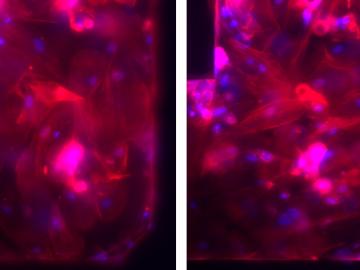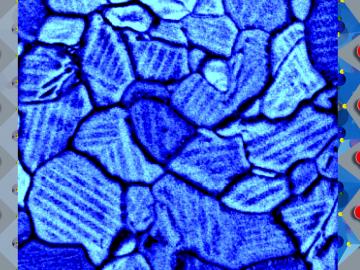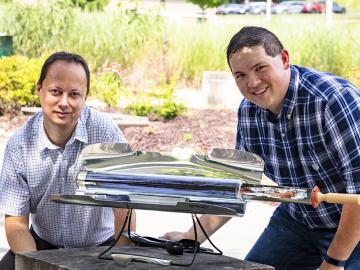
Filter News
Area of Research
- (-) Materials (433)
- (-) Nuclear Science and Technology (74)
- Advanced Manufacturing (34)
- Biological Systems (18)
- Biology and Environment (177)
- Biology and Soft Matter (5)
- Building Technologies (12)
- Chemical and Engineering Materials (4)
- Chemistry and Physics at Interfaces (11)
- Clean Energy (522)
- Climate and Environmental Systems (14)
- Computational Biology (6)
- Computational Chemistry (5)
- Computational Engineering (5)
- Computer Science (19)
- Data (1)
- Earth Sciences (1)
- Electricity and Smart Grid (3)
- Energy Frontier Research Centers (14)
- Energy Sciences (5)
- Fossil Energy (3)
- Fuel Cycle Science and Technology (3)
- Functional Materials for Energy (16)
- Fusion and Fission (54)
- Fusion Energy (17)
- Geographic Information Science and Technology (3)
- Isotope Development and Production (3)
- Isotopes (35)
- Materials Characterization (2)
- Materials for Computing (36)
- Materials Synthesis from Atoms to Systems (13)
- Materials Under Extremes (12)
- Mathematics (1)
- National Security (79)
- Neutron Data Analysis and Visualization (4)
- Neutron Science (190)
- Nuclear Systems Modeling, Simulation and Validation (3)
- Nuclear Systems Technology (1)
- Quantum Condensed Matter (4)
- Quantum information Science (9)
- Reactor Technology (1)
- Renewable Energy (4)
- Sensors and Controls (5)
- Supercomputing (311)
- Transportation Systems (11)
News Type
News Topics
- 3-D Printing/Advanced Manufacturing (26)
- Advanced Reactors (14)
- Artificial Intelligence (9)
- Big Data (2)
- Bioenergy (12)
- Biology (4)
- Biomedical (8)
- Buildings (5)
- Chemical Sciences (32)
- Clean Water (3)
- Climate Change (5)
- Composites (9)
- Computer Science (19)
- Coronavirus (5)
- Critical Materials (13)
- Cybersecurity (5)
- Decarbonization (8)
- Energy Storage (34)
- Environment (16)
- Exascale Computing (2)
- Frontier (3)
- Fusion (15)
- Grid (5)
- High-Performance Computing (4)
- Irradiation (1)
- Isotopes (16)
- ITER (1)
- Machine Learning (5)
- Materials (73)
- Materials Science (79)
- Mathematics (1)
- Microscopy (27)
- Molten Salt (7)
- Nanotechnology (39)
- National Security (3)
- Net Zero (1)
- Neutron Science (38)
- Nuclear Energy (49)
- Partnerships (11)
- Physics (31)
- Polymers (17)
- Quantum Computing (3)
- Quantum Science (11)
- Renewable Energy (1)
- Security (2)
- Simulation (1)
- Space Exploration (7)
- Summit (2)
- Sustainable Energy (14)
- Transformational Challenge Reactor (5)
- Transportation (14)
Media Contacts



A unique combination of imaging tools and atomic-level simulations has allowed a team led by the Department of Energy’s Oak Ridge National Laboratory to solve a longstanding debate about the properties of a promising material that can harvest energy from light. Th...

Chemists at the Department of Energy’s Oak Ridge National Laboratory have demonstrated a practical, energy-efficient method of capturing carbon dioxide (CO2) directly from air. They report their findings in Nature Energy. If deployed at large scale and coupled to geo...

The United Kingdom’s National Nuclear Laboratory and the U.S. Department of Energy’s Oak Ridge National Laboratory have agreed to cooperate on a wide range of nuclear energy research and development efforts that leverage both organizations’ unique expertise and capabilities.

Lithium-ion batteries commonly used in consumer electronics are notorious for bursting into flame when damaged or improperly packaged. These incidents occasionally have grave consequences, including burns, house fires and at least one plane crash.

An Oak Ridge National Laboratory-led team used a scanning transmission electron microscope to selectively position single atoms below a crystal’s surface for the first time.

Experts focused on the future of nuclear technology will gather at Oak Ridge National Laboratory for the fourth annual Molten Salt Reactor Workshop on October 3–4.

Scientists at the Department of Energy’s Oak Ridge National Laboratory induced a two-dimensional material to cannibalize itself for atomic “building blocks” from which stable structures formed. The findings, reported in Nature Communications, provide insights that ...



